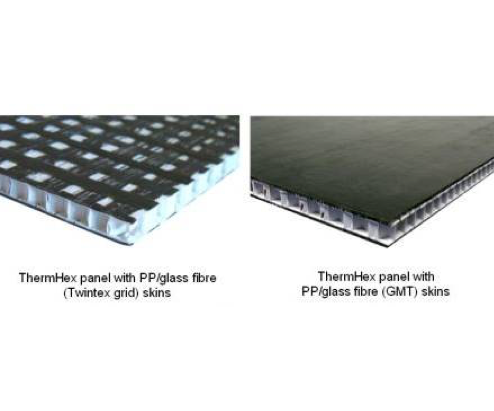EconCore licenses Fynotej for NA automotive applications and advances into high-performance thermoplastics (HPT)
Branded Fynocore, these panels have a PP honeycomb core with skins – thermally bonded in-line – in either solid PP sheet or including a non-woven surface finish.
Fynotej (Mexico City, Mexico), a well-known manufacturer of high-quality automotive non-wovens, is the first licensee in North America focused on automotive applications for EconCore’s (Leuven, Belgium) ThermHex thermoplastic honeycomb core production technology. Fynotej began production earlier this year with a range of polypropylene (PP) honeycomb sandwich panels for automotive interiors, including trunks. Branded Fynocore, these panels have a PP honeycomb core with skins – thermally bonded in-line – in either solid PP sheet or including a non-woven surface finish, combining low weight with high performance and esthetics.
“Fynocore products combine our expertise and experience in non-wovens with EconCore’s ThermHex honeycomb technology,” says Daniel Kalach, VP of Manufacturing at Fynotej. “They fit very well with automotive market trends: they are recyclable, moisture inert, conversion is clean and fast, parts are high in performance but low in weight, and, most of all, costs are competitive. We are excited to be able to offer these innovative products to our customers throughout North America.”
Daniel Kalach says Fynotej is already looking at high-volume non-automotive applications that will also benefit from the performance advantages of PP honeycomb panels. The company is eyeing building and industrial applications in particular. “We are very excited about our honeycomb production line which has now been started up in Mexico City. This highly versatile technology that offers an extensive range of opportunities but most importantly it meets the most critical market needs – performance and cost efficiency,” adds Kalach.
Tomasz Czarnecki, COO at EconCore, says the successful start-up of the Fynotej production line is a significant step forward for lightweight thermoplastics honeycomb composites in the North American automotive sector. “It is one of the latest additions to our network of licensees, which now spans Europe, Asia and North America, covering applications not only in automotive, but – depending on the evolutions, potentially also in commercial transportation, building and construction, reusable industrial packaging and more,” he says.
Czarnecki goes on to highlight the success of another EconCore licensee in North America, Wabash National Corp., the region’s leading producer of semi-trailer and truck bodies. “The combination of thermoplastic honeycomb core with metal skins is another example of the versatility of the EconCore technology. The light-weighting efforts of Wabash National fit well into the market trends. The transportation and logistics markets, with regards to fuel efficiency regulations but also in view of pure cost savings targeted by fleet managers, are asking for a change.”
High-performant thermoplastic (HPT) products in PC, PA 66 and PPS
EconCore is now further exploiting the versatility of the ThermHex technology. It has broadened its focus to high-performance thermoplastic (HPT) honeycomb core materials and sandwich panels. “The high speed continuous technology has been proven to be a logical fit for high-volume applications using commodity thermoplastics,” says Czarnecki. “Now we are extending its capabilities to produce honeycomb cores in engineering plastics, including modified polycarbonate, polyamide 66, polyphenylene sulfide (PPS) and others.”
EconCore has already successfully produced and tested honeycombs in several HPTs at its recently-refurbished R&D facilities in Leuven, Belgium.
HPT honeycombs will build on the intrinsic benefits of lightweight honeycomb structures, adding improved heat resistance (useful for such products as housings for electric vehicle batteries) and very good flame resistance (critical for building panels). EconCore is also working with materials modified for FST (flame, smoke, toxicity) compliance in railway and aerospace applications. It sees substantial potential in photovoltaic (PV) panels and numerous other products too.
EconCore is readying a variant of the ThermHex technology for production of PP honeycomb cores thermally bonded between skins of PP reinforced with continuous glass fibers. These organosandwich materials offer an outstanding ratio of stiffness to weight and can be converted into final parts – also in-line if desired – using such quick and efficient processes as thermoforming and over-molding. Compared to more conventional composite and metal-based solutions, they offer superior light-weighting potential and important cost benefits.
Related Content
Jeep all-composite roof receivers achieve steel performance at low mass
Ultrashort carbon fiber/PPA replaces steel on rooftop brackets to hold Jeep soft tops, hardtops.
Read MoreInfinite Composites: Type V tanks for space, hydrogen, automotive and more
After a decade of proving its linerless, weight-saving composite tanks with NASA and more than 30 aerospace companies, this CryoSphere pioneer is scaling for growth in commercial space and sustainable transportation on Earth.
Read MoreCryo-compressed hydrogen, the best solution for storage and refueling stations?
Cryomotive’s CRYOGAS solution claims the highest storage density, lowest refueling cost and widest operating range without H2 losses while using one-fifth the carbon fiber required in compressed gas tanks.
Read MoreMaterials & Processes: Composites fibers and resins
Compared to legacy materials like steel, aluminum, iron and titanium, composites are still coming of age, and only just now are being better understood by design and manufacturing engineers. However, composites’ physical properties — combined with unbeatable light weight — make them undeniably attractive.
Read MoreRead Next
Composites end markets: Energy (2024)
Composites are used widely in oil/gas, wind and other renewable energy applications. Despite market challenges, growth potential and innovation for composites continue.
Read MoreFrom the CW Archives: The tale of the thermoplastic cryotank
In 2006, guest columnist Bob Hartunian related the story of his efforts two decades prior, while at McDonnell Douglas, to develop a thermoplastic composite crytank for hydrogen storage. He learned a lot of lessons.
Read MoreCW’s 2024 Top Shops survey offers new approach to benchmarking
Respondents that complete the survey by April 30, 2024, have the chance to be recognized as an honoree.
Read More





























